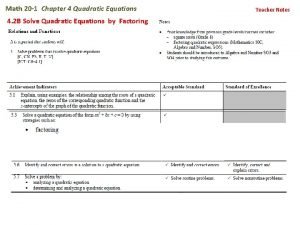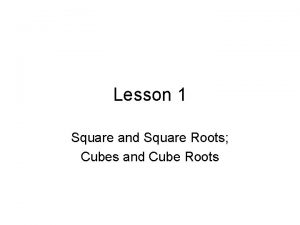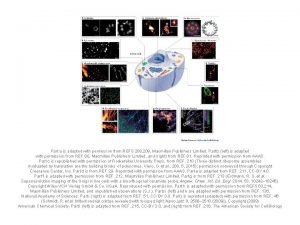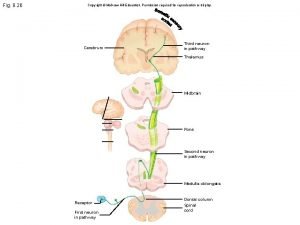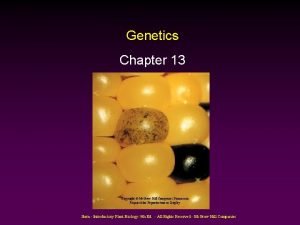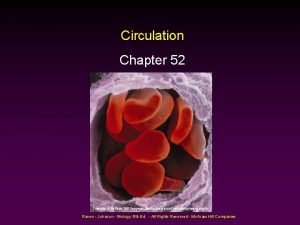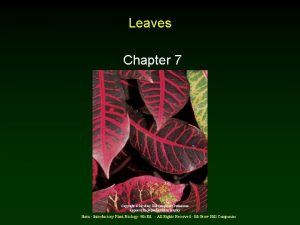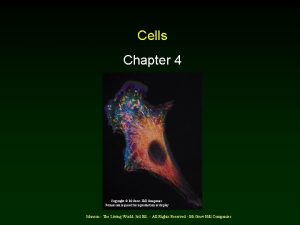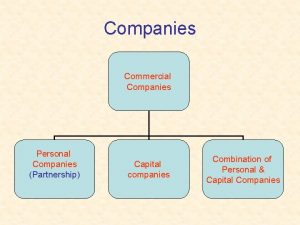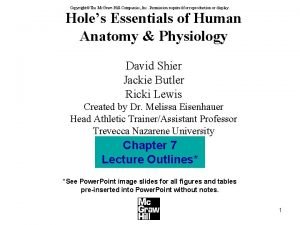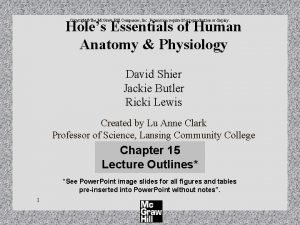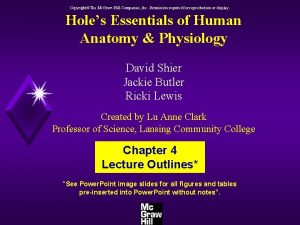Roots Chapter 5 Copyright Mc GrawHill Companies Permission


































- Slides: 34

Roots Chapter 5 Copyright © Mc. Graw-Hill Companies Permission Required for Reproduction or Display Stern - Introductory Plant Biology: 9 th Ed. - All Rights Reserved - Mc. Graw Hill Companies

Outline • • • Root Function Root Development Root Structure Specialized Roots Mycorrhizae Root Nodules Stern - Introductory Plant Biology: 9 th Ed. - All Rights Reserved - Mc. Graw Hill Companies

Function • • There are several functions for a root v Anchorage v Water and mineral absorption/conduction v Storage - Starch - Water Extensive underground organ v A single grass plant 6 3 - 15 x 10 roots = 400 miles of root / 2 ft soil Stern - Introductory Plant Biology: 9 th Ed. - All Rights Reserved - Mc. Graw Hill Companies

Stern - Introductory Plant Biology: 9 th Ed. - All Rights Reserved - Mc. Graw Hill Companies

How Roots Develop • When a seed germinates, the embryo’s radicle grows out and develops into the first root. Stern - Introductory Plant Biology: 9 th Ed. - All Rights Reserved - Mc. Graw Hill Companies

Root development Radicle Stern - Introductory Plant Biology: 9 th Ed. - All Rights Reserved - Mc. Graw Hill Companies

Development: Tap root -- Fibrous root • • May develop into thick taproot with branch roots. v Dicotyledonous Plants May develop a fibrous root system. v Monocotyledonous Plants Adventitious roots are roots that develop from non-root plant parts Both monocots and dicots Stern - Introductory Plant Biology: 9 th Ed. - All Rights Reserved - Mc. Graw Hill Companies

Adventitious Roots Stern - Introductory Plant Biology: 9 th Ed. - All Rights Reserved - Mc. Graw Hill Companies

What are the advantages and disadvantages of a fibrous and a taproot system? Advantages • • Fibrous v Large surface area, increased access to water and minerals Taproot v Good for a storage of nutrients, can access water and nutrients at great depths, good during drought periods Stern - Introductory Plant Biology: 9 th Ed. - All Rights Reserved - Mc. Graw Hill Companies

Disadvantages • • Fibrous v Does not reach water and nutrients deep in soil profile - not good during drought v Not good for storage of water or carbohydrates Taproot v Not as efficient as fibrous at getting water & minerals in upper soil profile. Stern - Introductory Plant Biology: 9 th Ed. - All Rights Reserved - Mc. Graw Hill Companies

ROOTS • • • Root Function Root Development Root Structure Specialized Roots Mycorrhizae Root Nodules Stern - Introductory Plant Biology: 9 th Ed. - All Rights Reserved - Mc. Graw Hill Companies

Root Structure 1. 2. 3. 4. • • Root Cap Region of Cell Division Region of Cell Elongation Region of Cell Maturation Not all regions well-defined at their boundaries. Development in roots unlike other organs follows a linear vector Stern - Introductory Plant Biology: 9 th Ed. - All Rights Reserved - Mc. Graw Hill Companies

Root Structure and Root Tissue Comparison Stern - Introductory Plant Biology: 9 th Ed. - All Rights Reserved - Mc. Graw Hill Companies

Root Structure • Root Cap - Thimble-shaped mass of parenchyma cells covering each root tip. v Protects tissue from damage. v Function in gravity perception. v Cells secrete a slimy substance and slough off forming a slimy lubricant that helps roots move through soil Stern - Introductory Plant Biology: 9 th Ed. - All Rights Reserved - Mc. Graw Hill Companies

Region of Cell Division • Root apical meristem • 12 to 36 h cell cycle Stern - Introductory Plant Biology: 9 th Ed. - All Rights Reserved - Mc. Graw Hill Companies

Region of Elongation • • About 1 cm from root tip Cells become several times their original length. v Vacuoles merge and form 90% of the mature cell Stern - Introductory Plant Biology: 9 th Ed. - All Rights Reserved - Mc. Graw Hill Companies

Region of Maturation • • • Sometimes called “region of differentiation” or “roothair zone” Most cells differentiate into various distinctive cell types. Vascularization and development of root hairs Stern - Introductory Plant Biology: 9 th Ed. - All Rights Reserved - Mc. Graw Hill Companies

Region of maturation Root hairs Tuberous extensions of specialized epidermal cells • • Absorb water and minerals and adhere tightly to soil particles. Grass plant 2 ft 3 soil, 15 x 106 roots has 14 x 109 root hairs - • Root surface area ~ volleyball court Root hair surface area ~ football field Root hairs function for 2 days to 3 weeks Stern - Introductory Plant Biology: 9 th Ed. - All Rights Reserved - Mc. Graw Hill Companies

Region of Maturation Cortex cells • • Cortex cells mostly store food Between epidermis and inner tissues. v Has endodermis as inner boundary (single layer cells) - Cell walls impregnated with suberin bands; Casparian Strips. Ø Forces all water and dissolved substances entering and leaving the central core to pass through plasma membranes of the endodermal cells. Stern - Introductory Plant Biology: 9 th Ed. - All Rights Reserved - Mc. Graw Hill Companies

Region of Maturation Cortex cells Stern - Introductory Plant Biology: 9 th Ed. - All Rights Reserved - Mc. Graw Hill Companies

Region of Maturation • Vascular Cylinder lies at the inside of the endodermis. (xylem/phloem) Stern - Introductory Plant Biology: 9 th Ed. - All Rights Reserved - Mc. Graw Hill Companies

Development of Secondary Roots • Pericycle lies directly against the inner boundary of the endodermis. v Lateral (branch) Roots develop Stern - Introductory Plant Biology: 9 th Ed. - All Rights Reserved - Mc. Graw Hill Companies

What structure within the root is responsible forming secondary or lateral roots? • • • A. Casparian strip B. Vascular cambium C. Cork cambium D. Pericycle E. Endodermis Stern - Introductory Plant Biology: 9 th Ed. - All Rights Reserved - Mc. Graw Hill Companies

Specialized Roots • Food Storage Roots v Sweet Potatoes v Yams • Store starch, carbohydrates Stern - Introductory Plant Biology: 9 th Ed. - All Rights Reserved - Mc. Graw Hill Companies

Specialized Roots • Carrots, beets, turnips, radishes are foodstorage tissues that are a combination of root and stem Stern - Introductory Plant Biology: 9 th Ed. - All Rights Reserved - Mc. Graw Hill Companies

Specialized Roots • • Manroot (Marah) Water Storage Roots v Pumpkin Family Propagative Roots v Adventitious Buds develop into suckers. - Fruit Trees Sisal Stern - Introductory Plant Biology: 9 th Ed. - All Rights Reserved - Mc. Graw Hill Companies

Specialized Roots • Pneumatophores v Spongy roots that extend above the water’s surface and enhance gas exchange between the atmosphere and subsurface roots. Mangroves Stern - Introductory Plant Biology: 9 th Ed. - All Rights Reserved - Mc. Graw Hill Companies

Specialized Roots • Aerial Roots-can absorb water from the air; has a thick epidermis to reduce water loss v Orchids v Banyan trees www. hcs. ohio-state. edu/ hcs 300/anat 1. htm Stern - Introductory Plant Biology: 9 th Ed. - All Rights Reserved - Mc. Graw Hill Companies

Specialized Roots • • Contractile Roots v Pull plant deeper into the soil. - Lilly Bulbs. Buttress Roots v Stability - Tropical Trees. Stern - Introductory Plant Biology: 9 th Ed. - All Rights Reserved - Mc. Graw Hill Companies

Mycorrhizae fungi • Mycorrhizae form a mutualistic association with plant roots. (found in 3/4 of all seed plants) v Fungus is able to absorb and concentrate phosphorus much better than it can be absorbed by the root hairs. Stern - Introductory Plant Biology: 9 th Ed. - All Rights Reserved - Mc. Graw Hill Companies

Mycorrhizae fungi Two Hibiscus plants. Left plant without Mycorrhizae, right with Mycorrhizae. Mucorrhizal arbuscule inside a plant cell www. botany. hawaii. edu/faculty/ wong/BOT 135/Lect 26. htm Stern - Introductory Plant Biology: 9 th Ed. - All Rights Reserved - Mc. Graw Hill Companies

Root Nodules • Few species of bacteria (Rhizobium) produce enzymes that can convert nitrogen into nitrates and other nitrogenous substances readily absorbed by roots. v Legume Family (Fabaceae) - Root nodules contain large numbers of nitrogen-fixing bacteria. Stern - Introductory Plant Biology: 9 th Ed. - All Rights Reserved - Mc. Graw Hill Companies

Root Nodules Stern - Introductory Plant Biology: 9 th Ed. - All Rights Reserved - Mc. Graw Hill Companies

Review • • • Root Development Root Structure Specialized Roots Mycorrhizae Root Nodules Stern - Introductory Plant Biology: 9 th Ed. - All Rights Reserved - Mc. Graw Hill Companies
 Grawhill
Grawhill Grawhill
Grawhill Grawhill
Grawhill Grawhill
Grawhill Mc grawhill
Mc grawhill Mc grawhill
Mc grawhill Grawhill
Grawhill Mc grawhill
Mc grawhill Grawhill
Grawhill Vanessa jason biology roots
Vanessa jason biology roots Estimating square roots notes
Estimating square roots notes Lesson 3 existence and uniqueness
Lesson 3 existence and uniqueness The roots of american imperialism 1. economic roots
The roots of american imperialism 1. economic roots Sum of the roots and product of the roots formula
Sum of the roots and product of the roots formula What are all of the perfect squares
What are all of the perfect squares Particular partnership
Particular partnership Permission slip for water day
Permission slip for water day Sdcc planning permission
Sdcc planning permission Adani gate pass
Adani gate pass Adapted with permission from
Adapted with permission from Modal verbs obligation and permission
Modal verbs obligation and permission Expressing permission
Expressing permission Dialogue asking for permission
Dialogue asking for permission Romeo and juliet summary act 1 scene 2
Romeo and juliet summary act 1 scene 2 Permission slip for water day
Permission slip for water day Way leave facility
Way leave facility Therapy dog permission slip
Therapy dog permission slip Demander la permission en classe
Demander la permission en classe Permission obligation and prohibition
Permission obligation and prohibition Shall asking for permission
Shall asking for permission Tehnike internet marketinga
Tehnike internet marketinga Jeus8 설치 가이드
Jeus8 설치 가이드 Request offer permission
Request offer permission May not be reproduced without permission
May not be reproduced without permission Image permission
Image permission













